
If you need to ship something from China to the USA, here is a shipping guide for you.
It contains all the factors you need to consider when shipping goods from China to the USA: mode of transportation, shipping process, transmit time, shipping cost, tax & duty, risk of shipping and so on. It will help you to improve transportation efficiency and safety, reduce your transportation costs, and save you valuable time and effort.
Usually, you can choose the following three main modes of transportation for your shipment from China to the USA:
Ocean freight shipping is the most important mode of transportation in international trade between China and the United States, and most of the goods imported and exported from China to the United States are transported by this way. The large volume and low cost of ocean freight are its advantages. While it has its inadequacy, like slow speed limited, navigational risk of bad weather, or even be robbed by pirates. Ocean freight is suitable for large shipments and does not rush in time.
Air freight is a fast and reliable modes of transportation from China to the USA. Compared with sea freight, air freight has the advantages of speed, safety and punctuality.
Air shipment is usually used in areas where time requirements are high, goods are of great importance and cannot be reached by other modes of transportation.
Air freight with its fast and punctual characteristics greatly shorten the delivery time, to speed up the capital turnover and circulation of the owner has played a great role in promoting, but the cost of air freight is relatively high.
If the size of the goods is small, and there are high requirements for speed and security, you can choose international Courier services. Major international Courier companies have extensive coverage within China, offering door-to-door services.
Before choosing a mode of transportation, you need to consider the type of goods, package size, weight, volume, value, time requirements, and your shipping budget.
At the same time, it is also necessary to understand and meet the relevant export and import requirements, such as export declaration, import clearance, shipping documents, etc.
It is recommended to compare as many different freight forwarders' services and prices as possible before choosing a mode of transport to ensure that you choose the one that best suits your needs and budget.
It is also possible to consult a professional freight forwarding company who can provide more detailed and personalized guidance.
Sea freight is divided into FCL and LCL two ways, both of them have their own advantages and application scenarios in the international freight. The choice of which method to use depends on factors such as the characteristics of the goods, quantity, timeliness and budget.
FCL usually means that goods are transported in the form of an entire container, which is suitable for situations where the volume of goods is large or needs to be shipped independently.
If your cargo can be filled a container, or even 75% or more of a container, then FCL transportation may be the most economical option.
FCL shipping is faster than LCL shipping because there is no need to spend time merging or splitting your shipments with others.
FCL shipping is also safer than LCL shipping because the whole box remains sealed during the entire transportation process until it reaches your designated destination, unless the customs requires opening the box for inspection.
FCL type and model—Which type or model of container to use needs to be selected based on comprehensive considerations such as the type, nature, shape, packaging, volume, weight, and transportation requirements of the goods. The general selection principle is to choose the most economical type or model of container on the basis that the goods can be loaded and meet the transportation conditions required by the goods.

The rate of FCL---Fuel prices, transport distance, cargo type and quantity, vessel size and type, port fees and taxes, market supply and demand conditions are the main factors affecting the price of international sea freight.
Some of these factors are things that we can predict and control (such as choosing what kind of vessel), while others are things that we cannot predict nor control (such as fluctuations on the prices of fuel and the changes in market supply and demand). It is important for companies and individuals who need to use international shipping services to understand and recognize these factors in order to better manage and control shipping costs.
The whole container is priced at a fixed rate at that time, whether the container is fully filled or not.
While in different time, the price is waving. The shipping company will update the price every week in fact.
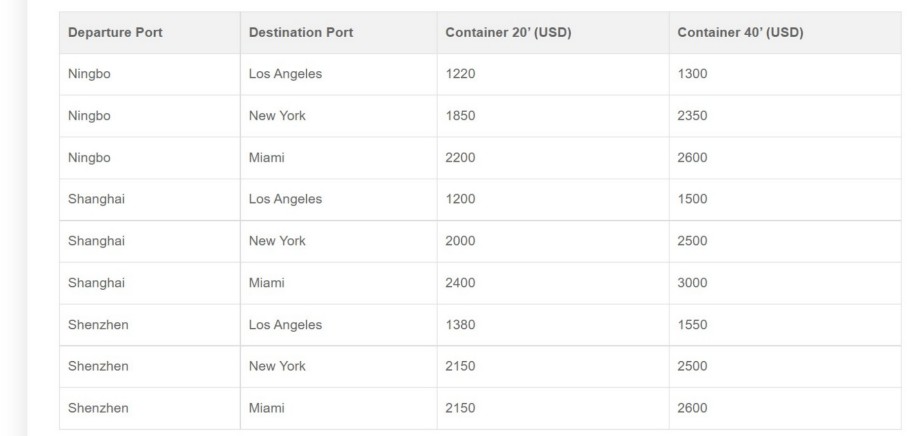
2.2. Sea freight- LCL
LCL is a relative term for FCL, which means combining multiple goods and loading them into one container for transportation. This mode of transportation is suitable for situations where the volume of goods is small and does not fill a container. By combining the goods of multiple customers into the same container, the utilization rate can be maximized, the waste of space can be reduced, and the transportation cost can be reduced. Since LCL goods will share space with goods from other companies, the process of consolidating and packing at the port of departure and unpacking and sorting the goods at the port of destination is increased. Therefore, under the same circumstances, the delivery time of LCL is usually longer than that of FCL. The box length varies from about 5 to 10 days.
The basic principle of LCL billing is based on the actual occupied space or weight. There are usually two types of billing basis:
A). Billing based on actual volume: Billing is based on the container space occupied by the goods, usually in cubic meters. Specific billing methods can vary based on the size and type of container.
B). Billing based on actual weight: Billing is based on the weight of the goods, usually in KG. Among them, the weight can be confirmed through weighing equipment, quality certificates, delivery orders, etc.
It should be noted that the specific LCL charging standards may vary depending on different countries, transportation methods and freight forwarding companies. Therefore, when performing LCL transportation, it is recommended to conduct detailed consultation with a professional logistics company or freight forwarder to ensure an accurate understanding of the relevant billing rules.
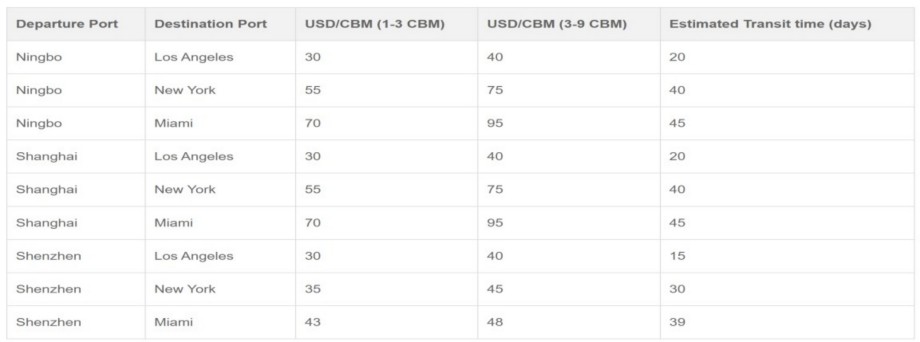
Major ports in China include Shanghai Port, Shenzhen Port, Guangzhou Port, Qingdao Port, Tianjin Port, Dalian Port, Ningbo Port, Wenzhou Port and Xiamen Port. These ports play an important role in logistics transportation. Among them, Shanghai Port and Shenzhen Port are the two largest ports in China. They are located at the mouth of the Yangtze River and the Zhujiang River respectively and are one of the busiest ports in the world.
The main ports (also called basic ports) in the western United States are: Los Angeles, Long Beach, Seattle, Oakland, Portland, San Francisco, and Tacoma. The main ports (also called basic ports) in the eastern United States are: New York, Savannah, Miami, Houston, Norfolk, Jacksonville, Charleston, Atlanta, Baltimore, Boston, Mobile, New Orleans, Everglades Port, Philadelphia, Savannah, Tampa. In addition to the basic ports, the main inland points in the United States are: Denver, Chicago, Charlotte, Cincinnati, Cleveland, Columbus, Detroit, Kansas City, Louisville, Memphis, Minneapolis, Norfolk, Nashville, Newark, Pittsburgh, Salt Lake City, San Antonio, St. Louis, Orlando, etc.
Under normal circumstances, shipping from China to the United States goes to basic ports in the United States for unloading. The basic ports have complete facilities and are connected to the land transportation network, which is conducive to further distribution and distribution of goods. For those goods that need to be transported to inland areas of the United States, other modes of transportation, such as rail, road or inland shipping, are usually selected to transport the goods to the destination after unloading is completed at the basic port. This ensures that goods can reach inland areas quickly and safely, and reduces transit links in logistics.
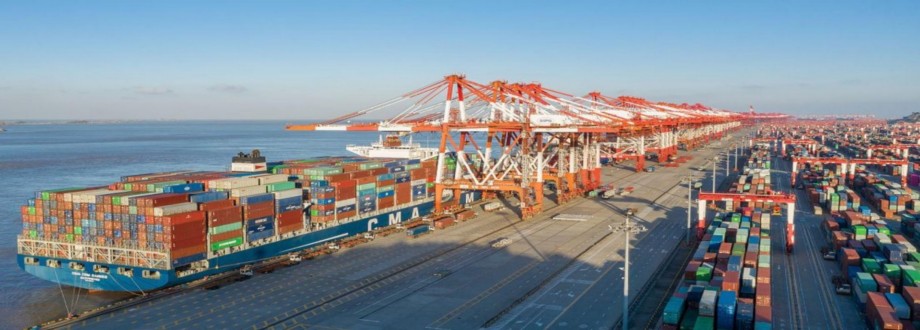
There are many shipping companies can be chosen from China to the USA, and each one has its own advantages. Generally, it manifested in the following aspects:
A) Speed (number of sailing days)
B) Layover (call)
C) Shipping capacity (TEU)
D) Services at the destination port
E) Dispatching capabilities,
The following is a summary of the advantages and disadvantages of current mainstream shipowners. You can make an appropriate choice based on cost, timeliness and other needs.
2.4.1 Matson -- Fast boat.
Advantage: Mason Express has two main routes, namely CLX (regular ship) and CLX+ (overtime ship). It departs from Shanghai to Long Beach Port in the West Coast of the United States, with an average sailing time of 10-11 days. It is currently the fastest route from China to the West Coast of the United States. route. The main difference between the regular shift and the overtime shift is the docking station. The regular shift ship docks at an independent private dock, which can ensure the same unloading speed for ten years (fast enough). Therefore, the Matson regular shift ship is almost unaffected during the peak season. Able to maintain the stability of the entire route. Overtime ships dock at public piers, and the speed of unloading and picking up containers is slower than that of regular ships. However, if the overtime ship is lucky, it may dock at a private dock, but the premise is that the crew members on the overtime ship must all be American citizens.
Disadvantage: Currently, the US shipping line has the highest price. In addition, the route is relatively simple, only going to the western United States -- LB port.
2.4.2 ZIM -- Fast boat.
Advantage: The Israeli shipping company provides ZEX e-commerce routes with stable timeliness and fast container unloading. It departs from Yantian Port with a fixed sailing time and an average voyage of 12-14 days. It resumed sailing in November 2023. The timeliness was unstable, and we need to wait and see the specific timeliness.
Disadvantage: The price is relatively high. There is poor flexibility in handling unexpected special situations.
2.4.3 CMA
Advantage:
Line EXX (Yantian-Ningbo-Shanghai-Los Angeles-Oakland-Honolulu) is an express route specially designed by CMA for highly time-sensitive cargo. It has a short voyage, high on-time rate, and will mark time-sensitive cargo with a "priority cargo" mark. When goods arrive at the Port of Los Angeles, there are dedicated storage yards and dedicated truck channels, and the goods can be quickly unloaded and departed from the port.
Line EX1 (Qingdao-Shanghai-Busan-Los Angeles-Oakland) is another line served by CMA EXX Clipper. The voyage is slower than EXX, but it is also ranked at the front of the actual voyage in the current market. The punctuality rate is relatively good, and other characteristics Similar to EXX.
Disadvantages: Often orders cannot be placed due to lack of boxes, and the cabinet cannot be picked up.
2.4.4 COSCO
Advantage: COSCO is the shipowner with the best service and timeliness among ordinary ships. Compared with Matson and other fast ships, the price is much more affordable. The SEA and SEAX routes launched by COSCO have an average shipping schedule of about 16 days. They provide non-return of containers and quick pick-up services at the destination port. The docking terminal LBCT is the most automated Los Angeles terminal. It takes 2-4 days to pick up the containers after arrival. favored by overseas e-commerce sellers.
Disadvantages: It is easy to lack cabin space during peak season.
2.4.5 OOCL
Advantages: It has been acquired by COSCO, with stable routes and competitive prices. The flagship routes PVSC and PCC1 dock at LBCT Terminal, the most automated terminal in Los Angeles. Unloading and picking up containers are very efficient. The average shipping time is 14-18 days.
Disadvantages: In peak season, it is easy to be unable to place an order due to lack of boxes, and cannot pick up the cabinet.
2.4.6 EMC
Advantages: It has a dedicated terminal and has fixed delivery services for HTW and CPS routes. Battery space is available, and the timeliness is stable during normal times. The average sea route time is 13-14 days. You can collect goods in South China and sail from Yantian.
Disadvantages: Delays, warehouse liquidation, etc. are prone to occur during peak seasons, which in turn causes the speed of picking up containers at the destination port to be slower.
2.4.7 MSK
Advantages: One of the largest shipowners in the world, the fleet has multiple routes and a wide range of routes, provides sufficient space, transparent prices, and convenient online booking.
Disadvantages: The timeliness is relatively slow, and there is a risk of liquidation and dumping.
2.4.8 MSC
Advantages: routes are all over the world, there are many and large ships, the space price is relatively low, and we can accept non-hazardous zone guaranteed battery cargo. We can accept heavier goods at no additional price.
Disadvantages: The bill of lading has been too slow, the shipping schedule is unstable, the route has many ports of call, and the route is long. It is not suitable for customers with high shipping schedule and timeliness requirements.
2.4.9 HPL
Advantages: One of the five largest shipping companies in the world and a member of THE Alliance (HPL/ONE/YML/HMM). The price is affordable and the cabin space is relatively abundant.
Disadvantages: Weak flexibility in handling emergencies and special circumstances.
2.4.10 HMM
Advantages: We can receive battery goods, provide MSDS, transportation appraisal report, and letter of guarantee, and can ship them as regular goods. We provide freezers, dry-freeze cabinets, and can also accept dangerous goods, and the price is relatively cheap.
Disadvantages: Occasionally the bill of lading speed is slow.
The shipping routes from China to the United States are roughly divided into East-U.S. and West-U.S. routes.
The West Coast routes generally depart from Chinese ports (Yantian, Xiamen, Ningbo, Shanghai, etc.) and arrive at ports in the West Coast via the Pacific Ocean. Major ports in the Western United States, such as Los Angeles (LA/Los Angeles), Long Beach (LB/Long Beach), Oakland (Oakl), etc., if you choose a fast ship, the voyage time is 11-16 days, if you choose a slow ship, it will take 18-25 days About a day's voyage. China's cross-border e-commerce goods generally dock at the Port of Long Beach or the Port of Los Angeles, which are also the two busiest ports in the Western United States. For example, COSCO, ZIM, CMA, etc. all dock at these ports. Take the Matson Regular Shipping (CLX) route as an example. CLX is the direct route from Ningbo-Shanghai to Long Beach Port.
The US Eastbound route is subdivided into eastbound routes and westbound routes. The eastbound route needs to pass through the Pacific Ocean, then through the Panama Canal to the Atlantic Ocean and then to the East US ports. The westbound route will pass through the Strait of Malacca, then through the Suez Canal to the Mediterranean Sea, and finally through the Atlantic Ocean to the Eastern United States. Major ports in the eastern United States include New York, Savannah, Charleston, etc. The fast ship takes about 30 days to sail, while the slow ship takes about 40 days to sail. Of course, you can also choose to transport the freight to the West Coast first, and then transport it inland to the East Coast. The delivery time is about 21-25 days, so the freight cost will be higher than taking the East Coast route.
In addition to the sailing time of the ship, it is also necessary to consider the time it takes for the goods to arrive at the destination port for customs clearance, unloading, container pick-up, container unpacking, sorting, and delivery. Therefore, it usually takes 3 to 7 weeks from the time the order is placed until the goods are finally delivered to the consignee's designated destination.

There are many modes of air transportation, which can be divided into direct flights and transfer flights according to routes:
Direct Flight
It means it is the same flight that for the entire flight from the departure airport to the destination airport. It may land and stop in the middle, or it may not land and fly directly to the destination.
It should be noted that the flights that stop by may also be direct flights, because direct stops are generally technical stops, such as just to refuel the aircraft or unload some cargo, and the stop time will not be long, usually between 2- Within 4 hours. Direct flights are generally available on the same day, or within 1 to 2 days.
The advantage of direct flights is that the transportation time is fast and the probability of losing goods due to multiple transfers is reduced. The disadvantage is that it is more expensive than other types of air transportation modes.
Transfer Flight
Transfer Flight is also called a connecting flight, a flight transfer or a stopover. It means that the plane stops midway, transfers the cargo at the departure point, loads it onto the plane of another flight, and continues the next itinerary. It may experience more than one transfer in the middle. until the destination airport.
The journey from the departure point to the transfer point is generally called the first route. If there is another transfer from the transfer point to the destination, this trip is what we often call the second route. Generally, airlines' transit airports are their hub airports or aviation bases, such as LAX Airport in Los Angeles, USA. The transfer time generally ranges from 3 to 8, depending on the specific route and destination.
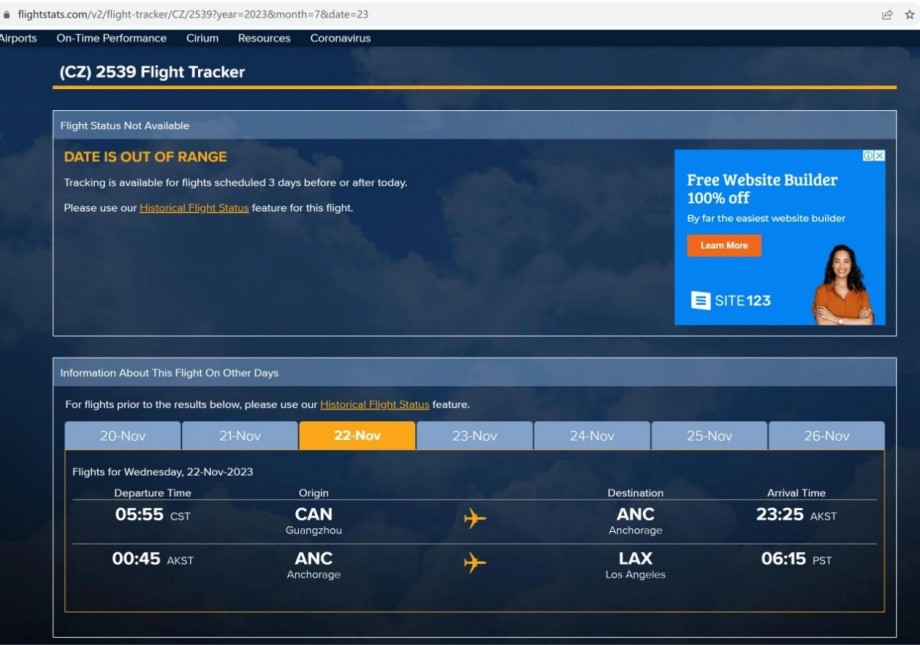
The advantage of air freight
1. Fast timeliness, saving time and cost;
2. The cargo damage rate is low, and the air transport operation process is very strict, so the probability of cargo damage and loss is very low;
3. The requirements for goods packaging are low, the transportation process is relatively smooth, and the loss and damage of goods can be avoided;
4. Large space span and many routes;
5. Save warehousing costs. Due to the fast timeliness of air transportation, goods can be transported in small quantities multiple times, saving a lot of warehousing costs.
Goods suitable for air transport
Suitable for products with high timeliness requirements---This is one of the advantages of international air transport is its fast timeliness, which is very suitable for transporting goods with high timeliness requirements, such as fresh goods, seasonal goods, etc. Fresh products have high requirements on timeliness. Air transportation can ensure the freshness and survival rate of goods, facilitate the development of long-distance markets, and avoid losing the original value of goods due to transportation delays. For seasonal goods, air freight can ensure the market before the peak sales season and avoid the cost of missing the peak season and not being able to sell.
Suitable for high-value goods - Another advantage of international air transport is its high safety, and it is also very suitable for transporting high-value goods, such as various electronic products, mobile phones, electronic watches, accessories, laptops, tablets, etc. Light weight, high value, suitable for international air transportation.

How is air freight billed?
According to airline regulations, the weight of cargo is divided into gross weight and volumetric weight. Whichever weight is greater will be charged, that is: billing weight (kg) = MAX (volume weight/gross weight).
Volumetric weight (kg) = (length cm x width cm x height cm) / 6000. Note that the length, width and height are the dimensions of the cargo packaging, in centimeters (cm).
Gross weight (kg) = the actual weight of the goods itself, in kilograms (kg).
Billable weight is called Chargeable Weight, or C.W. for short, which is the weight based on which freight are calculated. The billable weight is either the actual gross weight or the volumetric weight. The billable weight = Gross weight VS volumetric weight, whichever is greater is the weight for calculating transportation charges.
According to density, air cargo can be divided into three types: flat cargo, heavy cargo, and bubble cargo. According to international regulations, the standard 1CBM=167KG is the dividing line. If it reaches the standard, it is called flat cargo. If it exceeds 167kg, it is collectively called heavy cargo. Otherwise, it is called bubble goods or light cargo.
So, chargeable weigh of the bubble goods is volumetric weight. For example shipping cotton, as the volumetric weight is much heavier than gross weight. The billable weight = volumetric weight.
How do it cause volume weight?
Since the cargo hold capacity of the aircraft is limited, in order to balance the relationship between the actual weight of the cargo and the volume occupied by the cargo when charging freight charges, the International Air Transport Association (IATA) has uniformly determined the standard formula of "volume weight".
In the case of centralized consignment, there will be multiple pieces of goods under the same waybill, including heavy goods and light goods. At this time, the chargeable weight of the goods will be calculated based on the total gross weight or the total volumetric weight of the goods, whichever is higher.
That is to say, first calculate the actual gross weight of the entire batch of goods;
Secondly, calculate the total volume of the batch of goods and find the volumetric weight;
Then, compare the two values and use the higher one as the chargeable weight of this shipment.
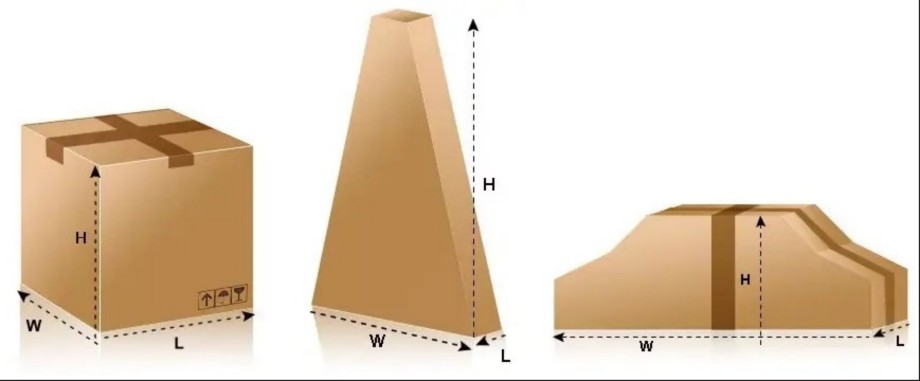
Air Freight Sensitive Cargo Classification
Contains battery
For example, power banks, Bluetooth headsets, shavers, beauty instruments, built-in batteries for toys, etc. Containing batteries refers to items that can store electricity. Many electronic products have built-in batteries. All items that are used for charging contain batteries. Please pay attention to the distinction!
Contains liquid
For example, shampoo, skin care products, essential oils, mouthwash, glue, etc. Liquid refers to a small amount of non-toxic and non-irritating liquid. You can choose to send it through sensitive channels by air. If there are liquid goods, please be sure to package them before delivery so that no liquid can leak out. Large quantities of liquids cannot be transported by air. If you have any questions, please consult us
Contains paste
For example, cosmetics, facial cream, lipstick, toothpaste, eyeliner, eyeshadow, etc. Paste goods mostly include cosmetics, skin care products, and food items.
Contains magnetism
For example, magnets, speakers, magnetic jewelry, refrigerator door magnetic strips, washing machine water inlet and drain valves, radios, tape recorders, headphones, stereos, nuclear magnetic resonance machines, etc. Magnetic items are commonly found in toys such as horns (items that make sound).
Some powder items
For example, powder puff, loose powder, baking soda, etc. Unpackaged, white powder, indistinguishable powder, etc. cannot be mailed.
Contains motor
For example, soymilk machines, vacuum cleaners, electric fans, hair dryers, clothes dryers, water pumps, etc. Motors are also electrical machines, commonly found in electrical appliances and toys.
Contains food
For example, snacks, nuts, dry foods, condiments, packaged foods, instant noodles, etc. Fresh food and food that requires frozen transportation cannot be mailed. If you mail food items, please first confirm whether the shelf life is longer than the transportation time.
Contains electrical appliances
For example, monitors, printers, sweeping robots, etc. Commonly found in air conditioners, kitchen appliances, lighting appliances, ironing appliances, and cleaning appliances.
Contains brands
For example, LV, CHAXEL, GUCCK, Adidas, Nike, Anta, etc. Branded goods purchased by individuals in small quantities through formal channels can be sent to sensitive channels. Bulk purchases and purchases through informal channels are prohibited from being sent.
Other types
For example, adult products, some religious products, CDs without content, etc.
For other types of uncommon goods, please inquire to confirm whether they can be shipped.
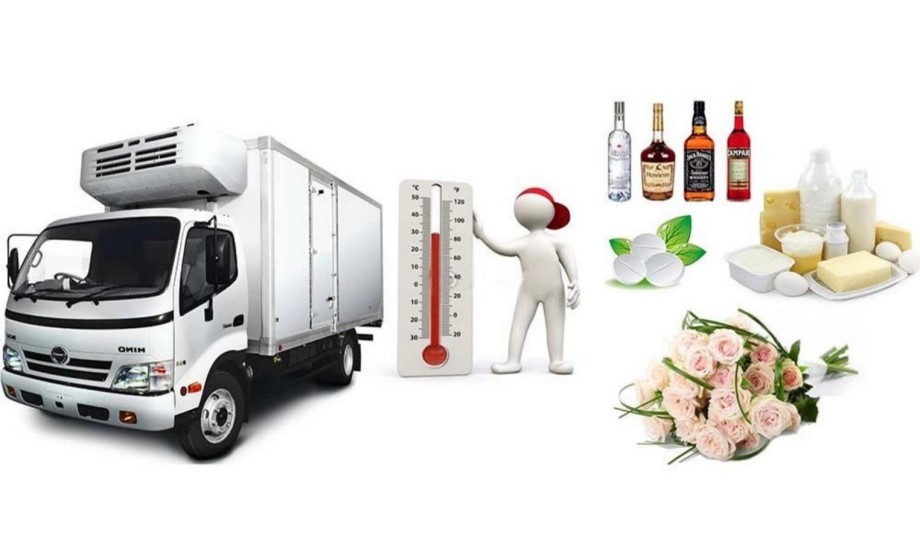
Main airports in China
When shipping from China to the United States, professional freight forwarders will provide you with freight solutions that solve different needs based on the location of your goods and the specific conditions of the goods. You can choose to use any of the following China International Freight forwarders based on the freight forwarder's professional solutions. Airport to transport your cargo.
Shanghai Pudong International Airport(IATA: PVG, ICAO: ZSPD) is located in Pudong New Area, Shanghai, China, about 30 kilometers away from the center of Shanghai. It is a 4F civil airport. It is one of China's three major gateway complex hubs, a member of the Yangtze River Delta region's international air cargo hub group, and a member of the East China Airport Group. It is the largest hub airport and gateway airport in East China.
Beijing Capital International Airport(IATA: PEK, ICAO: ZBAA) is located in Chaoyang District, Beijing, China, 25 kilometers from the center of Beijing to the southwest and 67 kilometers from Beijing Daxing International Airport to the south. It is a 4F-level international airport. It is one of China's three major gateway complex hubs and the Bohai Rim region. A member of the international air cargo hub group and the world's largest airport.
Shenzhen Bao'an International Airport(IATA: SZX, ICAO: ZGSZ) is located in Bao'an District, Shenzhen City, Guangdong Province, China, on the east bank of the Pearl River Estuary. Its geographical coordinates are 113°49° east longitude and 22°36° north latitude. It is 32 kilometers away from Shenzhen City. It is a 4F-level civil transport airport. It is one of the top 100 airports in the world, an international hub airport, one of the 12 major trunk airports in China, and one of the four major air cargo centers and express distribution centers in China.
Guangzhou Baiyun International Airport (ICAO: ZGGG, IATA: CAN) is located at the junction of Renhe Town, Baiyun District, Guangzhou City, Guangdong Province, and Xinhua Street and Huadong Town, Huadu District, about 28 kilometers from the center of Guangzhou. It is a 4F-level civil international airport. It is one of the three major gateway complex hub airports in China and one of the top 50 major airports in the world.
Zhengzhou Xinzheng International Airport (IATA: CGO, ICAO: ZHCC), referred to as "Xinzheng Airport", is located at the junction of Xinzheng City and Zhongmu County, Zhengzhou City, Henan Province, China. It is a 4F-level international civil airport and the first airport in China. It is a core component of the Zhengzhou Airport Economic Comprehensive Experimental Zone, a national airport, an international air cargo hub airport, one of China's eight regional hub airports, a "7×24 hours" "all-time" customs clearance international airport, a large domestic aviation hub airport, and an international airport. Regular flight airports and national first-class aviation ports open to the outside world.
Hangzhou Xiaoshan International Airport (IATA: HGH, ICAO: ZSHC) is located in Xiaoshan District, Hangzhou City, Zhejiang Province, China, 27 kilometers away from the city center. It is a 4F civil transport airport and one of the 12 major trunk airports in China. Airports for scheduled international flights, first-class air ports open to the outside world and alternate airports for international flights.
Chengdu Tianfu International Airport (IATA: TFU, ICAO: ZUTF) is located on Konggang Avenue, Lujia Town, Jianyang City, Chengdu City, Sichuan Province, China (belonging to the construction scope of the Eastern Chengdu New District), 50 kilometers north of the center of Chengdu. It is 50 kilometers away from Chengdu Shuangliu International Airport in the northwest and about 14.5 kilometers away from Jianyang city center in the northeast. It is a 4F-level international airport, an international aviation hub, and the main hub of Chengdu International Aviation Hub.
Qingdao Liuting International Airport (IATA: TAO, ICAO: ZSQD) is located in Liuting Street, Chengyang District, Qingdao City, Shandong Province, China, about 23 kilometers away from the center of Qingdao. It is a 4E-level civil international airport. It is one of the twelve major trunk airports in China.
Xiamen Gaoqi International Airport (IATA: XMN, ICAO: ZSAM), As the most important international aviation hub between the Yangtze River Delta and the Pearl River Delta, Gaoqi Airport is an important international trunk airport and regional aviation hub port on the southeast coast. It is also the base airport of Xiamen Airlines Co., Ltd.
Main airports in USA
Although the overall cargo volume of air transport cannot be compared with that of sea transport, the proportion of GDP carried by air transport is very high. It is no exaggeration to say that air transport is a barometer of high value-added industries. Here are some important aviation logistics distribution centers in the United States:
Memphis International Airport (MEM) is the world's largest distribution center for Fedex air express and air cargo, ranking second in the world in air cargo throughput. Fedex is the heart of U.S. domestic next-day delivery. There are more than 200 cargo planes collecting and distributing every day. The scale of this distribution center currently ranks second in the world.
Louisville Airport (SDF) is the world's largest distribution center for UPS air express and air cargo, and its air cargo throughput currently ranks fifth in the world.
Louisville Airport (SDF) is the heart of UPS Airlines' next-day delivery in the United States. The scale of this distribution center is currently the fifth in the world. Similar to FedEx, in order to build a domestic next-day delivery network and an international express delivery network in the United States, it is necessary to have a super large HUB in the United States. The UPS HUB is set up at the Louisville Airport.
Cincinnati Northern Kentucky Airport (CVG) is the largest HUB of DHL International Express in the United States. It is also an airport that has become a major aviation logistics distribution center because of the express company. This airport is one of the four major distribution centers of DHL International Express' global network, responsible for the important task of DHL Global Express entering and leaving the United States. In addition to DHL, e-commerce giant Amazon has also built its own air logistics distribution center in CVG. In the future, CVG will also have large-scale development, with momentum approaching that of Memphis and Louisville.
Anchorage Airport (ANC) is located in Alaska, USA. It has a unique geographical location and is a stopping point and refueling station for most of the world's cargo airlines. It is known as the crossroads of international air logistics. It is an important node for gathering and distributing Asia-Pacific, Europe, Australia, West America, and East America. UPS and FedEx have their own hubs (or ECCF) at ANC, and the all-cargo aircraft of Air China, China Southern Airlines, and China Eastern Airlines also have second freedom at ANC. According to the editor's understanding, ANC should be the airport with the most second freedom rights (cargo aircraft) in the world.
Miami International Airport (MIA) is located in the southernmost part of Florida, USA. It is the gateway port for cargo entering and exiting South America. UPS, FedEx, and DHL all gather at MIA and set up HUB or ECCF. All other cargo airlines serving South America have set up bases in MIA, which shows the strong port function of MIA and the uniqueness of MIA's market orientation.
Los Angeles International Airport (LAX) is the gateway airport to the West Coast of the United States, with huge passenger and cargo throughput. For freight, LAX is the most important distribution center for Asia-Pacific imports and exports to the United States. The three major Chinese airlines, Cathay Pacific in Hong Kong, China Airlines in Taiwan, Evergreen, Japan Airlines, All Nippon Airways in Japan, Asiana Airlines in South Korea, Korean Air, etc. all have direct flights to LAX.
New York John F. Kennedy Airport (JFK) is an important gateway airport in the eastern United States, similar to LAX. The passenger and cargo throughput is very large. Because JFK is relatively close to Europe, it can be said that JFK is the most important cargo airport for Europe. Due to the large population in the eastern United States, the economy is huge. Major airlines in the Asia-Pacific region also have direct all-cargo flights to JFK.
Chicago O'Hare International Airport (ORD), an important gateway airport in the central United States. For Chicago Airport, the cargo operating environment is much better than that of JFK and LAX (these two airports have serious traffic jams, huge cargo volumes, very difficult to pick up cargo, and the airport’s ground operation capabilities are limited). It is also worth mentioning that due to ORD Located in the middle of the United States, the time for land collection and distribution has certain advantages compared to other places.
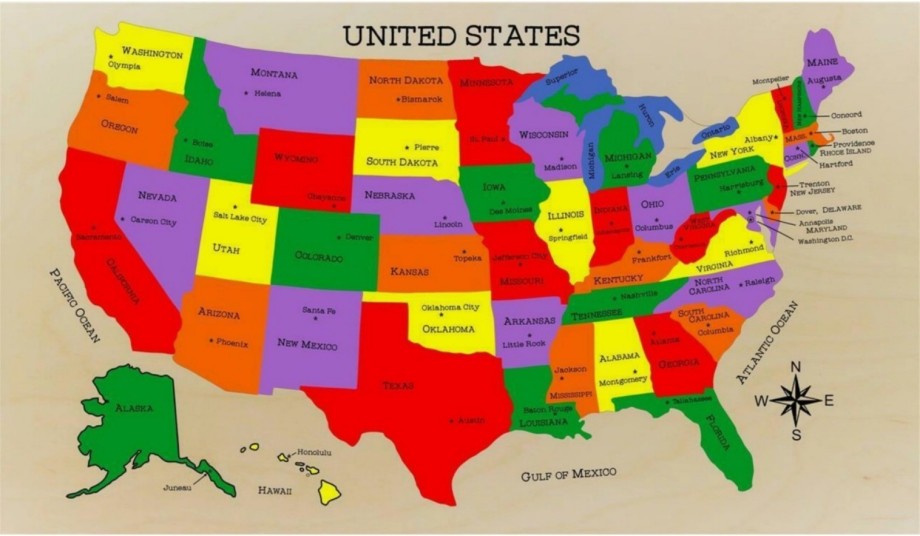
Airlines from China to the United States
China Southern Airlines(CZ)
Advantage:
- Direct flights: China Southern Airlines provides direct flights from Guangzhou to Los Angeles (CAN-LAX), reducing the time and hassle of connecting flights.
- Independent cargo terminal: They have an independent cargo terminal at the destination port, which facilitates the handling and transportation of goods.
Disadvantage:
- High prices: China Southern Airlines’ transportation prices are relatively high, which may put some pressure on some customers with limited budgets.
- Unable to do full plate extraction: This means that the goods cannot be extracted as an entire plate, which may increase the complexity of operation and management in some cases.
- Impact of depaneling at cargo terminals during peak seasons: During peak seasons, cargo terminals may need to depanel, which may affect the transportation and timeliness of goods.
China International Airlines(CA)
Advantage:
- Fixed board: CA has fixed cargo boards that can be retrieved in full, improving the efficiency of operation and management.
- Not affected by cargo station demolition during peak seasons: Compared with other airlines, Air China is not easily affected by cargo station demolition during peak seasons, ensuring the transportation and timeliness of cargo.
Disadvantage:
- Transfer requirements: Due to the need for transfers, second-leg flights may be affected by uncertain factors, such as flight delays or cancellations, which may cause certain inconvenience to the transportation of goods.
Korean Air (KE)
Advantage:
- Timeliness: Normally, Korean Air's transportation time is 2-3 days, which is relatively fast and suitable for customers who require fast transportation of goods.
- Independent destination port cargo terminal: They have an independent destination port cargo terminal, providing a convenient cargo handling and transportation environment.
- Secondary warehouse depaneling: Korean Air can perform secondary warehouse depaneling operations, increasing the flexibility and convenience of transportation.
Disadvantage:
- High prices: Korean Air’s transportation prices are generally high, which may put some pressure on some customers with limited budgets.
Asiana Airlines (OZ)
Advantage:
- Timeliness: Asiana Airlines can usually complete the transfer from Guangzhou, China to Incheon, South Korea, and then to Los Angeles, the United States, within 2-4 days, which is relatively fast.
- Independent destination port cargo terminal: They have an independent destination port cargo terminal, providing a convenient cargo handling and transportation environment.
- Secondary warehouse depaneling: Asiana Airlines can perform secondary warehouse depaneling operations, providing transportation flexibility.
Disadvantage:
- Non-fixed flights: Asiana Airlines’ flight schedule is not fixed, which may cause certain uncertainty in the reliability and planning of cargo transportation.
- Largely affected by the deplaning of cargo terminals during the peak season: During the peak season, Asiana Airlines may be affected by the deplaning of cargo terminals, which may have a certain impact on the transportation and timeliness of cargo.
American Kalitta Airlines (K4)
Advantage:
- Direct flights: Kalitta Airlines provides direct flights from Changsha to Los Angeles, reducing the time and hassle of connecting flights.
- Fast delivery time: Normally, Kalitta Airlines’ transportation delivery time is 1-2 days, which is suitable for customers who require fast cargo transportation.
- Independent destination port cargo terminal: Their destination port cargo terminal has secondary depaneling capabilities, providing a more flexible way of cargo handling and transportation.
Disadvantage:
- Limited flight frequency: Kalitta Airlines only has two flights per week, which may limit the flexibility and reliability of cargo transportation.
- Affected by the charter party's policies: Kalitta Airlines is affected by the charter party's policies, which may cause certain uncertainties in flight arrangements and cargo transportation.
American Atlas Air (5Y)
Advantage:
- Direct flights: Atlas Air provides direct flights from Nanchang to Los Angeles, reducing the time and hassle of connecting flights.
- Fast timeliness: Normally, Atlas Air’s transportation time is 1-2 days, which is suitable for customers who require fast cargo transportation.
- Independent destination port cargo terminal: Their destination port cargo terminal has secondary depaneling capabilities, providing a more flexible way of cargo handling and transportation.
Disadvantage:
- Limited flight frequency: Atlas Air has only three flights per week, on Tuesdays, Thursdays and Sundays, which may limit the flexibility and reliability of cargo transportation.
- Affected by the charter party's policies: Atlas Air's flights are charter flights and are affected by the charter party's policies, which may cause certain uncertainties in flight arrangements and cargo transportation.

The transit time from China to the USA depends on the mode of transport and the specific route. The most common modes of transportation are sea freight and air freight.
It usually takes you around 12~45 days to ship from China to USA by sea freight. while air freight is faster. The airlift transit time range will be 1 day to 15 days. However, these times may vary depending on factors such as customs clearance, weather conditions, and other transportation delays.
The fastest way to ship from China to USA is by air or by express. Which one to be chosen depends on your shipment quantity, packaging size, and timeliness requirements. CUC has rich experience in air freight and express delivery, and we will choose the most reasonable airline or express carrier for your shipment, according to your requirements.

It depends on the quantity of your shipment. If you just send documents, it must be the cheapest way to express, but if you ship in large shipment, there is no doubt that sea freight must be the cheapest channel among all transportation methods. Sea freight is one of the most popular transportation methods and an important transportation method for shipping cargoes from China to the US. Shipping from China to the US by sea is the specialty skill of CUC. Regardless of the volume, CUC can be combined flexibly to provide you with faster, more stable and cheaper services.
There are several items that cannot be sent to the USA, including:
1. Illegal drugs and narcotics, including marijuana.
2. Hazardous materials, such as explosives, flammables, and radioactive materials.
3. Weapons, ammunition, and related items, unless authorized by the US government.
4. Obscene or immoral materials, including child pornography.
5. Endangered species or wildlife products, such as ivory or rhinoceros horn.
6. Counterfeit goods and pirated media infringing on intellectual property rights.
7. Products violating US copyright or trademark laws, such as knockoff designer products.
8. Fireworks, whether personal or commercial.
9. Foods that are not packaged or properly labeled to comply with US requirements, or contain illegal or banned substances.
Additionally, there may be specific regulations and restrictions imposed by the US government that may prohibit or restrict certain products' importation. It is essential to check the US government's customs website or contact a customs broker or freight forwarder for further guidance on import restrictions and compliance requirements.
Your satisfaction are our utmost priority and we strive to provide professional, hassle-free, safe, secure, dependable and timely deliveries each and every time. After had tried our service, most of them become our regular customers and they praise for our service.
Since former U.S. President Barack Obama signed the Trade Facilitation and Trade Enforcement Act of 2015 in March 2016, the import duty-free amount has been increased from $200 to $800. Therefore, for Chinese goods imported into the United States, all items over $800 are subject to import taxes, depending on the specific item value and tax rate.
To calculate import duties, you need to know the value of the items and the tax rate.
You need to obtain the commodity value and HS CODE (or product name) , and then go to the website to query the corresponding tax rate through HS CODE (or product name).
When you have the value of the item and the tax rate, import taxes include:
Duty=Value * tax rate;
MPF=Value*0.3464% (Min USD32.71, Max USD634.62.);
HMF=Value*0.125% (Applicable to sea freight only).
In general, an import license is not necessary when shipping goods from China to the United States. However, certain products, due to their nature, may require specific permits, certifications, and licenses to be imported. It is essential to be aware of the regulations concerning the goods you wish to import to ensure that you comply with all relevant requirements. Proper research or consultation with a customs broker can ensure that your shipment meets all necessary regulations and avoid any potential complications with customs.
Incoterms are international commercial terms that define the responsibilities and obligations between buyers and sellers during international trade. Understanding and selecting the appropriate Incoterm is essential when shipping from China to the USA, as it outlines the responsibilities, transportation costs, and risks throughout the shipment process.
lf you are interested in our service, please leave your contact information to us, our expert will service you.